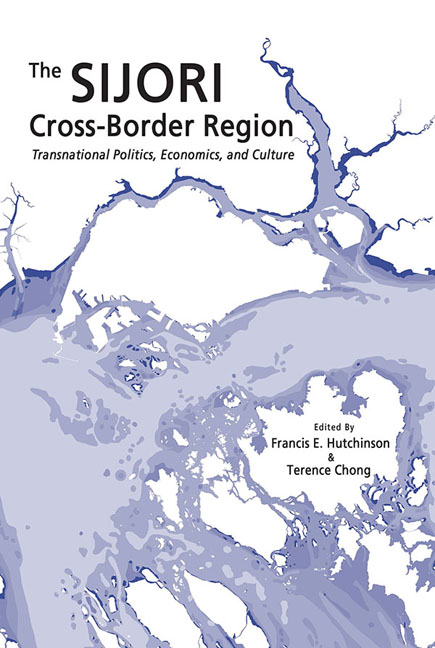Book contents
- Frontmatter
- Contents
- List of Maps
- List of Tables
- List of Figures
- Foreword
- Acknowledgements
- Contributors
- Abbreviations
- Introduction
- Map1
- 1 The SIJORI Cross-Border Region: More than a Triangle
- Section I Understanding the Whole
- Section II Policy and Politics
- Section III Cross-Border Social and Cultural Communities
- Section IV Formal and Informal Economies
- Conclusion
- Appendix
- Sources for the SIJORI Maps
- Index
1 - The SIJORI Cross-Border Region: More than a Triangle
from Introduction
Published online by Cambridge University Press: 22 July 2017
- Frontmatter
- Contents
- List of Maps
- List of Tables
- List of Figures
- Foreword
- Acknowledgements
- Contributors
- Abbreviations
- Introduction
- Map1
- 1 The SIJORI Cross-Border Region: More than a Triangle
- Section I Understanding the Whole
- Section II Policy and Politics
- Section III Cross-Border Social and Cultural Communities
- Section IV Formal and Informal Economies
- Conclusion
- Appendix
- Sources for the SIJORI Maps
- Index
Summary
INTRODUCTION
Twenty-five years ago, the governments of Singapore, Malaysia, and Indonesia agreed to jointly promote the city-state, the state of Johor in Malaysia, and the province of Riau in Indonesia. Bearing a range of labels, but most frequently referred to as the SIJORI Growth Triangle, this initiative sought to capitalize on the territories’ proximity, distinct factor endowments, and good logistics connections to present investors with an integrated “package”.
The concept was first articulated by then Deputy Prime Minister Goh Chok Tong of Singapore in late 1989, who referred to a “Triangle of Growth”. The Triangle initially encompassed the city-state, Johor to the north, and Batam Island in Riau Province to the south. The following year, the concept was endorsed by President Soeharto of Indonesia and Prime Minister Mahathir of Malaysia, and expanded to encompass the entirety of Riau Province. In 1994, a Memorandum of Understanding was signed by the governments of Singapore, Malaysia, and Indonesia to jointly develop and market the area (Phelps 2004, p. 348).
This concerted commitment was driven by the specific investment needs of the three countries. Singapore was in the midst of a deep restructuring process, and faced rising land and labour costs as well as an appreciating currency. This led to the country's regional industrialization strategy. This sought to: develop capabilities for the construction and administration of industrial properties in Asia; and encourage local and international investors to upgrade their operations in Singapore and relocate lower value-added operations to locations close by — often in parks owned by Singaporean government-linked corporations (Yeoh, Worthington and Wong 2003, p. 45).
Malaysia, for its part, was seeking to develop its industrial sector and deepen its technological capabilities. And, following a decline in commodity prices in the 1980s, the state of Johor was anxious to develop its manufacturing sector and compete with the incumbent industrial centres of Kuala Lumpur and Penang. Leveraging on its access to the city-state via a 1.2 kilometre bridge, it aimed to attract both Singaporean and international capital in higher technology sectors such as electronics (JSEPU 1989, pp. 124, 127; EEAU 1995, p. 43).
Indonesia had also long sought to attract capital and technology from Singapore through Batam, which was a mere 20 kilometres away. Efforts began to develop the island from the late 1970s, and consisted of expedited investment approvals as well as additional infrastructure expenditure
- Type
- Chapter
- Information
- The SIJORI Cross-Border RegionTransnational Politics, Economics, and Culture, pp. 9 - 30Publisher: ISEAS–Yusof Ishak InstitutePrint publication year: 2016

